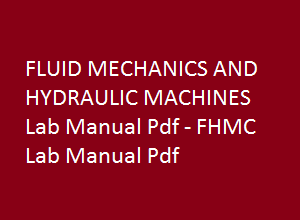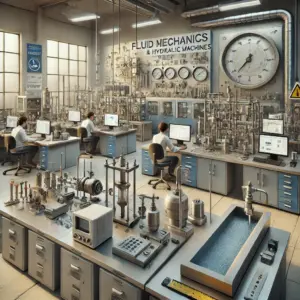Fluid Mechanics and Hydraulic Machines Lab Manual Pdf – FM & HM Lab manual pdf file
Please download the Fluid Mechanics and Hydraulic Machines Lab Manual Pdf – FM & HM Lab manual pdf file in the links below.
Overview
Fluid mechanics and hydraulic machines are critical components in engineering, playing a pivotal role in various industrial applications.
To master these concepts, practical knowledge through lab experiments is essential. This article provides an in-depth overview of the “Fluid Mechanics and Hydraulic Machines Lab Manual,” designed to aid engineering students in understanding these fundamental principles.
Download Link
Overview of Fluid Mechanics and Hydraulic Machines Lab Manual Pdf
The lab manual is structured to guide students through a series of experiments that illustrate key concepts in fluid mechanics and hydraulic machines. Each experiment includes objectives, required apparatus, detailed procedures, and analysis sections to ensure comprehensive understanding and practical skills development.
Experiment 1: Calibration of Venturi Meter
Objective: Determine the coefficient of discharge of the given Venturi meter.
Apparatus Required: Venturi meter, water supply, measuring tank, stopwatch.
Procedure:
- Connect the Venturi meter to the water supply.
- Measure the flow rate using the measuring tank and stopwatch.
- Record the pressure readings at different points along the Venturi meter.
Analysis: Calculate the coefficient of discharge using the recorded data.
Experiment 2: Calibration of Orifice Meter
Objective: Determine the coefficient of discharge of the given Orifice meter.
Apparatus Required: Orifice meter, water supply, measuring tank, stopwatch.
Procedure:
- Set up the Orifice meter with the water supply.
- Measure the flow rate and pressure drop across the orifice.
- Record the data for different flow rates.
Analysis: Analyze the data to calculate the coefficient of discharge.
Experiment 3: Determination of Friction for a Given Pipeline
Objective: Determine the coefficient of friction for a given pipeline.
Apparatus Required: Pipeline setup, water supply, pressure gauges, measuring tank, stopwatch.
Procedure:
- Connect the pipeline to the water supply.
- Measure the pressure drop across the pipeline for various flow rates.
- Record the flow rates and corresponding pressure drops.
Analysis: Use the data to calculate the friction factor for the pipeline.
Experiment 4: Verification of Bernoulli’s Theorem
Objective: Verify Bernoulli’s theorem experimentally.
Apparatus Required: Water supply tank, tapered inclined pipe, piezometer tubes, measuring tank, stopwatch.
Procedure:
- Set up the experimental rig with the inclined pipe and piezometer tubes.
- Allow water to flow through the pipe and record the pressure at different points.
- Measure the flow rate using the measuring tank and stopwatch.
Analysis: Compare the experimental data with theoretical values from Bernoulli’s theorem.
Experiment 5: Impact of Jet on Vanes
Objective: Study the impact of a water jet on different vanes.
Apparatus Required: Jet impact test rig, flat vane, curved vane, dead weights, stopwatch.
Procedure:
- Set up the test rig with the chosen vane.
- Direct the water jet at the vane and measure the force exerted.
- Repeat for different vanes and record the data.
Analysis: Analyze the impact forces and compare them for different vane shapes.
Experiment 6: Performance Test on Pelton Wheel
Objective: Conduct a performance test and plot the characteristics of the Pelton wheel turbine.
Apparatus Required: Pelton wheel test rig, water supply, tachometer, pressure gauge, stopwatch.
Procedure:
- Set up the Pelton wheel with the water supply.
- Measure the rotational speed and torque at different flow rates.
- Record the data and calculate the efficiency.
Analysis: Plot the performance curves of the Pelton wheel turbine.
Experiment 7: Performance Test on Francis Turbine
Objective: Conduct a performance test and plot the characteristics of the Francis turbine.
Apparatus Required: Francis turbine test rig, water supply, tachometer, pressure gauge, stopwatch.
Procedure:
- Set up the Francis turbine with the water supply.
- Measure the rotational speed, torque, and flow rate.
- Record the data and calculate the efficiency.
Analysis: Plot the performance curves and analyze the turbine characteristics.
Experiment 8: Performance Test on Kaplan Turbine
Objective: Conduct a performance test and plot the characteristics of the Kaplan turbine.
Apparatus Required: Kaplan turbine test rig, water supply, tachometer, pressure gauge, stopwatch.
Procedure:
- Set up the Kaplan turbine with the water supply.
- Measure the rotational speed, torque, and flow rate.
- Record the data and calculate the efficiency.
Analysis: Plot the performance curves and analyze the turbine characteristics.
Experiment 9: Performance Test on Centrifugal Pump
Objective: Conduct a performance test on a centrifugal pump.
Apparatus Required: Centrifugal pump test rig, water supply, pressure gauges, flow meter, stopwatch.
Procedure:
- Set up the centrifugal pump with the water supply.
- Measure the flow rate, head, and power input at different operating conditions.
- Record the data and calculate the efficiency.
Analysis: Plot the performance curves of the centrifugal pump.
Experiment 10: Performance Test on Two-Stage Centrifugal Pump
Objective: Conduct a performance test on a two-stage centrifugal pump.
Apparatus Required: Two-stage centrifugal pump test rig, water supply, pressure gauges, flow meter, stopwatch.
Procedure:
- Set up the two-stage centrifugal pump with the water supply.
- Measure the flow rate, head, and power input at different operating conditions.
- Record the data and calculate the efficiency.
Analysis: Plot the performance curves of the two-stage centrifugal pump.
Experiment 11: Performance Test on Reciprocating Pump
Objective: Conduct a performance test on a reciprocating pump.
Apparatus Required: Reciprocating pump test rig, water supply, pressure gauges, flow meter, stopwatch.
Procedure:
- Set up the reciprocating pump with the water supply.
- Measure the flow rate, head, and power input at different operating conditions.
- Record the data and calculate the efficiency.
Analysis: Plot the performance curves of the reciprocating pump.
Conclusion
Understanding fluid mechanics and hydraulic machines is crucial for any engineering student. The lab manual provides a comprehensive guide to essential experiments that reinforce theoretical knowledge through practical application. These experiments not only help in grasping complex concepts but also in developing hands-on skills that are invaluable in real-world engineering scenarios.
FAQs
Q1. Where can I download the Fluid Mechanics and Hydraulic Machines Lab Manual PDF? You can download the notes from the provided links for each unit or the complete
Q2. Where can I get the complete FM & HM Lab Manual PDF for free download?
You can download the complete lab manual for free from educational websites such as Smartzworld or directly through the provided link.


